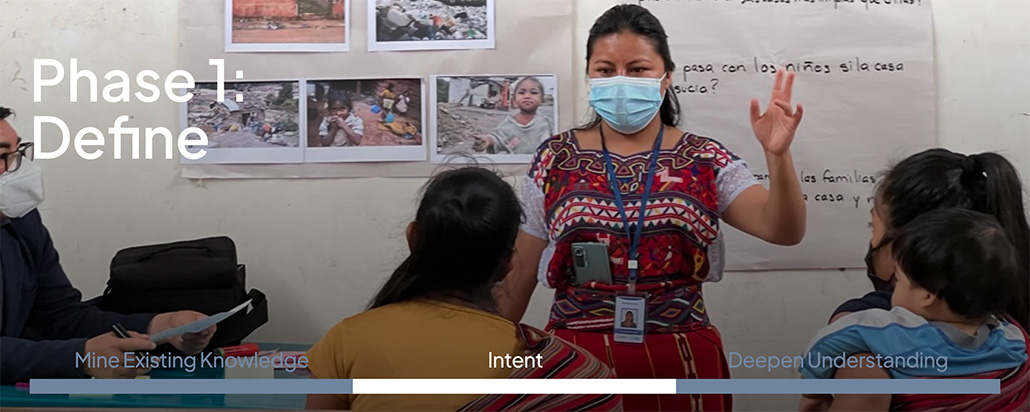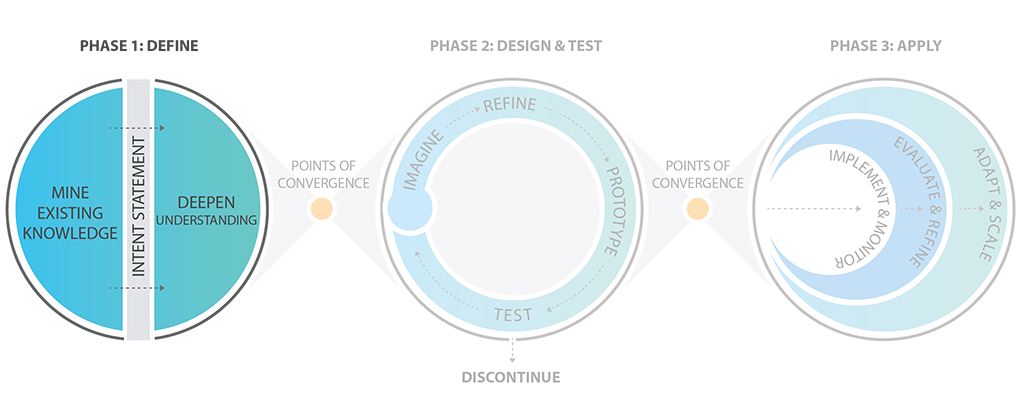Intent Statement

Guatemala, Define
Les Define Phase establishes the foundational understanding of the challenge from two perspectives: (1) existing knowledge and published literature, and (2) new, shared knowledge of lived experiences in households, communities, health systems, and political environments. It provides the opportunity to immerse oneself into the world in which people live and to design better solutions. This phase also provides an opportunity for key stakeholders to align with shared intent for the activity or project objective, building relationships and buy-in from the outset.

Intent Statement
What is the clear goal we are aiming for?
By the end of this step, your team will have a draft intent statement that builds consensus with key stakeholders by developing a shared vision and setting project objectives and future outcomes.
How to conduct this step and achieve its main objectives:
Prioritize Audience & Behaviors
Prioritizing is an important skill for building a strong program. It allows you to focus on where you will have the largest impact and helps inform future steps of the process.
Audience Profile Template
Suggested time:
3-4 hours
Participants:
Design and research team
Tool: Audience Profile Template
Audience profiles encapsulate the characteristics of product or service users, encompassing their needs, goals, and activities. These profiles are constructed through research involving real individuals and draw upon shared characteristics within a particular ecosystem. This tool serves as a valuable resource for organizing the wide-ranging needs and contexts of people. It offers a solid reference point to gain insight into the target audience and determine the most suitable solutions to support them.
Effort required:

Draft Intent Statement
The intent statement is a comprehensive agreement among stakeholders, consolidating discussions from the intent workshop into a finalized, reviewed, and agreed-upon document. It helps you to summarize the approach, goals, and processes and offers a snapshot of desired outcomes.
Intent Statement Template
Suggested time:
5–6 hours
Participants:
Design and research team, partners and
stakeholders, individuals you are designing for
Tool: Intent Statement Template
The intent statement stands as a cornerstone tool for clarifying the rationale behind the need for change. This valuable resource leads you through a structured process, prompting you to contemplate and achieve consensus on various project aspects. These include the current state, the envisioned future state, and the necessary changes to bridge the gap.
Effort required:

Develop a Theory of Change
Create a theory of change as your guiding beacon, alongside the intent document. This document outlines how and why the desired change is expected to occur in a specific context. Regularly revisit your theory of change during design, implementation, and evaluation to ensure alignment and strategic impact.
Theory of Change Template
Suggested time:
5–6 hours
Participants:
Design and research team
Tool: Theory of Change Template
This template walks you through how to develop a basic theory of change. It will help you to determine where you want to go as a project (desired results), how you are going to get there (the inputs, activities, and outputs directly associated with activities), and what you have to account for along the way (e.g., assumptions and external factors).
Effort required:

